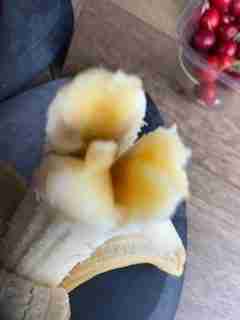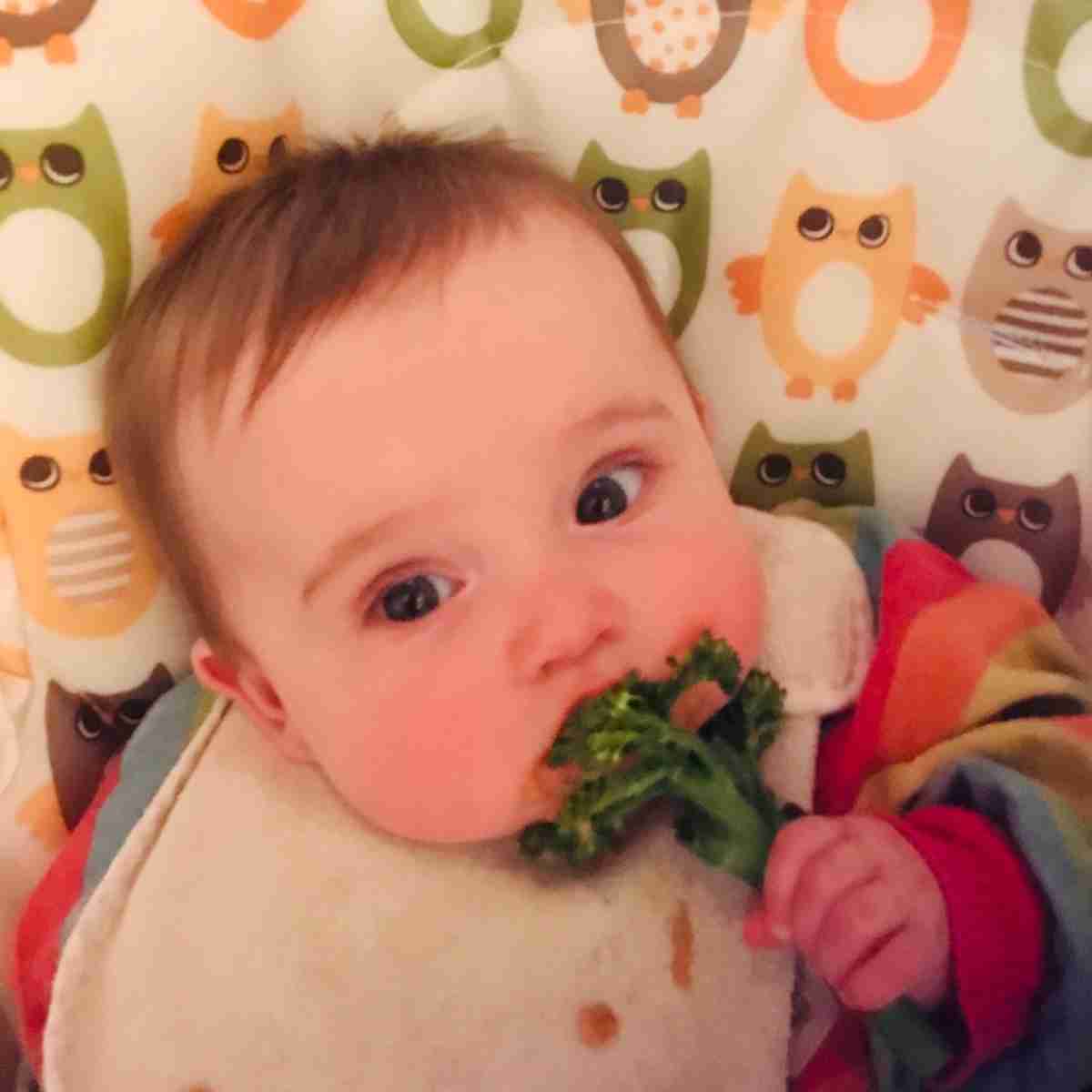Baby led weaning (BLW) is a great way to introduce your baby to a wide variety of colours, tastes, textures and shapes of food from an early age. So lets start with baby led weaning at breakfast.

Benefits of baby led weaning
Growing evidence suggests that babies who ‘lead their weaning’ are better at recognising their own fullness as they grow older and go on to develop a better relationship with food compared to those who are spoon fed (1)
When parents begin the exciting process of weaning with their baby, each meal presents a new opportunity to try different foods and benefit from the wide range of different nutrients naturally available to us.
Why is breakfast important when baby led weaning?
Baby led weaning breakfast is especially important to form as a habit early on; we know that children who eat breakfast display better academic performance, improved quality of life and lower risk of obesity (2).However, many parents struggle with ideas for weaning at breakfast time. It may take several months from the start of weaning before your baby can manage most textures and varieties of food.
But it can be challenging enough with sleep deprivation to think beyond a bowl of cereal (which may not be tolerated till 10 months to 1 year).
I have compiled a list of ideas for each stage of weaning for you to turn to when in need of some nutritious inspiration in the morning.
Points to remember when starting out with baby led weaning
How to start with baby led weaning at breakfast:
1.If you are planning to start solids the recommendations is around 6 months old but not before 17 weeks (3)
2. Make sure to include iron rich food sources as depletion occurs from around 6 months onwards- include tofu, beans, lentils, soft meats, well cooked eggs, finely ground mince, iron fortified whole grain infant cereal, chickpeas
3. Many parents are concerned that their child will choke. It is important to distinguish gagging from choking. Gagging is a perfectly normal response to learning to swallow solid foods and is often loud and your baby’s skin may turn red.
4. Choking, however, is silent and skin may look blue including inside their lips and on their fingernails and your child should receive immediate first aid and medical attention(4)
You should be wary of foods such as whole grapes, tomatoes, thick nut butters, popcorn, hard crusts and vegetables, hot dogs, whole nuts and round berries as they are a similar size to the airway.
5. Continue to give your baby their usual infant formula or breast milk. This remains their sole source of nutrition and in the early stages of weaning when nutritional intake from solid food is minimal
6. Start with introducing 1-2 foods per mealtime
7. Expect it to get messy and have fun
8. Allow purées and spoon feeding e.g., spoonful of yoghurt or puréed apple whilst they eat finger foods like toast with their hands. A flexible approach and responding to your baby’s needs can be beneficial for you and your baby
Baby led Weaning Breakfast ideas from 6 months old
The aim of this stage is to introduce your child to as many different foods from each food group (see below) as possible. Try introducing these foods at breakfast time and see what your baby tolerates.
· At this stage, it is important the texture is kept soft enough for your little one so that you can crush between your fingers.
· It may be difficult for little hands to grasp their food so rolling in ground nuts or leaving skin partially on foods like banana or mango to grip with can help.
· They may not eat very much at this stage, but it is important to keep reintroducing foods and trying a wide variety.
· Remember, their milk feed with still be their primary source of nutrition.

Whole-grains / carbohydrates
• Strips or crust of buttered toast
• Porridge with breast milk, formula milk or cow’s milk once it has been safely introduced. You can try sweetening with mashed banana, applesauce, and puréed berries but no honey due to infant botulism (5)
• English muffin- with cream cheese or egg and cut in small pieces to pick up
• Pancakes – try a recipe of 1 egg, 1 cup of flour and 1 cup of full fat milk or dairy free alternative milk with no added sugar (once egg, wheat and milk have been introduced safely individually to check for allergens)
Dairy
• Plain full-fat unsweetened yoghurt– try pre-loading onto a spoon for your baby to pick up and eat. Some brands do slightly thicker consistencies which may be easier to eat. You can also add chia seeds to thicken it up and leave overnight for an easy breakfast
• Pasteurised soft cheese e.g., mozzarella, cream cheese, cottage cheese or ricotta – never give unpasteurised dairy uncooked
Fruit and vegetables
• Thick avocado slices (on its own or mashed on toast strips)
• Banana- try cutting a 2-3 inch piece and leaving some of the skin on to grip
• Mixed fruit e.g., strawberries, kiwis (whole), peeled mango or melon
• Cooked and peeled apple slices or pear (try steaming till soft and mashable)
• Steamed vegetables e.g., carrot, broccoli, sweet potato, courgette (avoid tough and stringy skins)
Protein
• Eggs- Quartered hard-boiled eggs, scrambled or plain omelette cut into strips
• Dairy products listed above also contain high amounts of protein
• Nut butters thinned with water (smooth only)
Baby led weaning Breakfast ideas from 7 months
Your baby is expanding their food repertoire from 7 months and likely can begin to have larger, more ‘balanced’ meals. It is important to note that iron stores start to deplete at this age so including red meat, dried fruits (chopped finely) and smooth nut butters, fortified cereals, beans and tofu in the diet can help replenish stores.
Omega 3 is another essential nutrient needed for healthy brain function and found in oily fish such as salmon, mackerel, and sardines and in chia seeds, linseeds, tofu, walnuts, rapeseed oil and green leafy vegetables. Try to include some of these foods regularly. They may tolerate more of the options above and additionally, you can try these meals below…
• ½ boiled egg with 1 slice of buttered toast and sliced fruit
• Omelette made with cheese and spinach
• Muffins or crumpet with nut butter (thin with some water if too sticky) and banana
• Greek yoghurt and sliced fruit
• Half a bagel with smashed avocado and well cooked scrambled egg
• Yoghurt with stewed fruit
• Weetabix with full fat milk and finger food style fruit
• Porridge made with milk and stewed fruit/ fruit purée (try making a berry purée by microwaving blueberries until soft and sieve before serving)
• Salmon (boneless, smoked or baked) with scrambled egg
· Overnight oats with nut butter and fruit
BLW Breakfast from 10 months
At this stage, most foods will be suitable. Your baby may have mastered the pincer grip and are able to use age-appropriate cutlery and will likely tolerate more of the same foods and thicker / slightly harder consistencies
• Bowl of cereal – cheerios or shreddies (low sugar options) with some chopped fruit
• Boiled egg and toast soldiers with chopped fruit
• Scrambled eggs and toast/ half muffin / pita with finger fruit
• Omelettes with leftover steamed veggies and cheese
· Crumpet and smooth peanut butter
• Pancakes with cheese and soft peaches / fruit

Foods to Avoid when baby led weaning
There are certain foods to avoid in the first year of weaning.
– Foods high in salt e.g., bacon, sausages, chips with salt, takeaways and ready meals.
– Foods high in sugar e.g. sugary drinks like juice and sugary snacks
– Honey as it can lead to infant botulism
– Whole nuts and peanuts due to choking risk in under 5 years old
– Unpasteurized dairy e.g., mould ripened cheese, brie, camembert due to bacteria listeria
– Eggs that don’t have a red lion stamp
– Rice drinks as it can contain too much arsenic
– Raw or lightly cooked shellfish e.g. mussels, clams, oyster due to increase risk of food poisoning
– Shark, marlin and swordfish – due to the amount of mercury (6)
Conclusion
In conclusion , there is no one perfect way to wean your baby and it is important to do what works for you and your family. There are many delicious foods that can be enjoyed at breakfast time, providing essential nutrients for growing babies. Try to include a variety of different foods from the main food groups to ensure your baby gets a balance of all the nutrients they need.
If you’d like more like this, you can find more from me by downloading my new e-book or mini milk allergy course or for a one-to-one consultations, visit www.dietitianwithadifference.co.uk or follow me on instragram @dietitian.withadifference
Thank you to Hannah Eiseman Student Dietitian for helping with researching and writing the blog.



